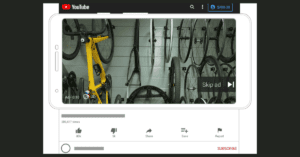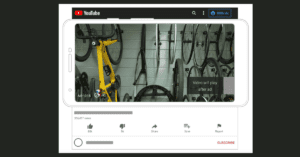With 2 billion users logged in each month, YouTube is the second most visited website in the world, and brands have advertisements there. With its wide audience and effective targeting options, YouTube is an unquestionably valuable platform for businesses at every stage of the customer journey. However, let’s be honest: YouTube ads aren’t the most obvious component of your social media marketing plan. You can be sure that investing a little more time now to learn the fundamentals will pay off in the long run.
Are you hoping to broaden the audience for your YouTube video? Then, setting up a YouTube ad campaign with Google Ads might be the answer for you. There are many different types of YouTube ads, including video ads, discovery ads, and more. You can target particular audiences, improve visibility, and increase traffic to your channel by using Google Ads for YouTube advertising.
YouTube advertisements can be an efficient investment for expanding your YouTube presence, even though their cost varies depending on your targeting options and bidding strategy. So, start using Google Ads to investigate the YouTube advertising options today!
This article will look at your available ad formats, youtube video promotion, walk you through the process of setting up a video YouTube ad campaign, provide you with the most recent ad specifications, and leave you feeling motivated by top tips from successful advertisers.
How to Advertise on YouTube 2023
First, let’s provide a general overview of YouTube ads. Four conditions must be met for YouTube advertising:
- an account on YouTube.
- an account with Google Ads.
- any number of video ads.
- Create a video campaign or campaigns.
YouTube Channel–
This is where your company’s YouTube channel is located. It might stand in for your company or personal brand.
You must have a YouTube channel before launching a YouTube campaign because all advertisements must be uploaded to YouTube before being used.
You don’t need a lot of videos or subscribers in order to run a paid campaign on YouTube, but you do need a channel where your ads will appear.
Google Ads Account –
Google Ads is used to run all of YouTube’s advertising campaigns. You can run campaigns using Google Ads on all Google networks (products and partner websites), including YouTube, Gmail, Discover, and Google Search.
As a way to evaluate how well your YouTube paid campaigns are performing, you should enable conversion tracking in order to achieve the best results.
Video Ads –
According to what you want your campaigns to accomplish, you can create a variety of youtube ads, as you can see below. Aside from the YouTube search results, you can make advertisements that play before or after videos, in the middle of them, and in many other locations.
Although there are limitations on the types of ad formats you can make (more on this below), you must first upload the ads to your own YouTube channel before using them in a campaign.
Video campaigns –
There are many types of campaigns you can set up on YouTube ads to find the right clients for your business. You can run promotions for a particular video to raise views, subscribers, brand awareness, sales, or a combination of these.
Numerous opportunities exist. For each campaign, you can customise your target audience, spending cap, ads, and a number of other aspects to ensure that every dollar spent on advertising will turn a profit.
What are the Types of YouTube ads?
Let’s start by looking at the main types of YouTube advertisements, both those with and without video:
- In-stream advertisements that can be skipped.
- Non-skippable bumper ads and in-stream advertisements.
- Video discovery ads (previously referred to as in-display ads).
- Banners and overlays that aren’t videos.
The majority of these formats are probably already familiar to you because you’ve probably already spent some time refining your YouTube marketing strategy. Let’s go over and examine the details, though.
IMPORTANT: How To Create A New Google Ads Account (Google Ads New Account) In April 2023 USA
Skippable in-stream YouTube ads –

On YouTube, these commercials might play before, during, or after other videos.
The user is given the chance to end the advertisement by clicking the “Skip Ad” button after it has played for 5 seconds.
If you use skippable in-stream ads, you won’t be charged unless someone engages with your ads (clicks on them to find out more or buy something) and watches at least 30 seconds of your video, or the entire thing if they only watch a portion of it.
Skippable in-stream advertisements are excellent for a variety of campaigns, including those aimed at increasing sales, acquiring leads, driving traffic to your website, and building brand awareness.
Bumper ads –

The maximum length of these advertisements on YouTube is 6 seconds, and they may run before, during, or after other videos. Users must wait for the ad to finish because they cannot skip the ads.
You are billed on impressions when using bumper ads when Target CPM bidding is used. You can specify how much you are willing to bid with this bidding option for each 1,000 times your ad is displayed.
Most brand awareness campaigns can benefit from bumper ads.
Non-skippable in-stream ads –

These YouTube ads are displayed prior to, during, or following other videos.
Users cannot select to skip the advertisement, which is their primary difference from skippable in-stream ads.
The fact that in-stream advertisements that cannot be skipped can last up to 15 seconds as opposed to just 6 seconds makes this type of advertisement different from bumper ads.
Target CPM bidding on impressions is used to monetize in-stream, non-skippable advertisements. Using this bidding option, you can specify the price you are prepared to pay for every 1,000 impressions of your advertisement.
Non-skippable in-stream advertising is very effective at increasing sales and brand awareness.
IMPORTANT: How To Find An Attorney In 2023 USA
In-feed video ads –
These advertisements can be seen on the home page of YouTube, in search results, next to related YouTube videos, or as suggested videos.
The text you specify when creating an In-feed video ad appears below the thumbnail image (from your video).
When using in-feed video ads, you pay every time a viewer clicks on a thumbnail and watches your video ad (regardless of what they do afterward).
You can increase views, subscribers, and sales by using in-feed video advertisements.
How to Create a YouTube Ads Campaign Step-By-Step 2023
You have two choices when starting a new YouTube channel or publishing a new video on the platform.
Using paid advertising (i.e. YouTube ads) to place the video in front of the appropriate audience and gain views or subscribers is an alternative to waiting for your video to rank organically on YouTube and receive the attention it merits.
The first option requires you to master YouTube SEO and have patience because it takes time for videos to rank organically on YouTube. Although it’s a great strategy and one that can produce long-term results, it’s not the best approach if you’re looking for a quicker solution.
Paid ads are your only choice if you want to draw viewers to your video as quickly as possible.
The advantages and disadvantages of using a paid youtube ads campaign to increase video views are as follows:
Pros–
- can increase the number of video views and gain social proof. Videos with more views have a higher chance of being seen by more people than videos with fewer views.
- With the help of audience targeting, you can display your videos to people who are most likely to watch them, like them, and subscribe.
- You can get comprehensive statistics on the effectiveness of your campaigns so you can see how many people watched the video, subscribed, etc.
Cons-
- It costs money. You will need a budget even though I’ll show you ways to cut your campaign costs.
- The video you plan to promote needs to be compelling enough to draw viewers in. All niches can benefit from this campaign type, but not all types of videos.
Follow these steps to create a YouTube Ads campaign to see if this is a tactic that works for your channel and videos:
- Enter your Google Ads account credentials, then select NEW CAMPAIGN.
- Click CONTINUE after selecting “Create a Campaign without a goal’s guidance”.
- Choose the VIDEO campaign type.
- Click CONTINUE after selecting CUSTOM VIDEO CAMPAIGN as the campaign subtype.
Make the following adjustments on the following screen:
- Give your campaign a name that is both memorable and descriptive.
- Select MAXIMUM CPV as your bid strategy. You can select the maximum amount you want to pay when your ad is viewed using this bidding option.
- Dates and budget – choose DAILY for the budget type and enter the daily spending cap for this campaign.
- As a general rule, you should always start a low budget, evaluate the results, and then gradually increase your budget as long as it generates a favourable return on investment when running any type of Google Ads campaign.
- You can begin with a budget of $10 per day for this video campaign. After two weeks, evaluate the campaign’s performance and adjust your budget accordingly.
- To make the remaining changes, scroll down and do the following:
- Networks – You can choose not to show your ads on “Video partners on the Display Network” in order to only have them appear on YouTube videos and search results.
- Locations: Use “Enter another location” to focus on the nations where your viewers and subscribers are likely to reside.
- If your channel is already popular, you can use the “Geography” report in your Channel Analytics to determine which nations receive the most video views and focus your paid advertising efforts there.
- By visiting YouTube Studio and choosing Analytics from the left menu, you can view the “Geography” report.
- Select GEOGRAPHY from the ADVANCED MODE tab by clicking on it.
- Sort the results using the filters according to the country, views, duration, and other criteria.
- You can use the GEOLOCATION report in Google Analytics to determine which nations are more likely to be interested in your content if your YouTube channel is also connected to a website or blog.
- Languages: Choose the tongue in which your users are fluent.
- Leave the default value of “Standard Inventory” for the inventory type.
- Leave excluded types and labels at their default settings to allow your ads to display on all content types other than unlabeled content.
- Videos related to your ad may appear below it on mobile devices ONLY. Using this option, you can display up to 5 such videos.
- Although this is a nice feature, we want to concentrate on just one video for the purposes of this campaign, so leave it empty and move on to the next steps.
- Then, to view and modify these settings, select the ADDITIONAL SETTINGS dropdown.
- Devices: Use the default settings.
- Frequency capping – Frequency capping enables you to limit the number of times the same user will see the ads.
- Set the “Impressions cap” to 2 per day and make sure “Cap impression frequency” is checked. As a result, the system will be forced to only display the same advertisement to a user a maximum of twice per day.
- Make sure “Cap view frequency” is checked, and set the “Views cap” to 1 per week. Users who have already viewed or interacted with the advertisement will no longer see it from that point forward (for a week).
- Combining these two options will increase the reach of your ads and ensure that they are seen by as many people as possible.
- Keep the default settings for the ad schedule.
- Maintain the default settings for third-party measurement.
- Your target market’s definition and ad group creation come next. This is a step that is essential to the success of your campaigns.
- You should try to do some research to determine precisely which group of people are more likely to be interested in your video advertisement because showing your ads to the wrong audience will waste both your budget and views.
To get some inspiration, consider the following advice:
- Exclude a demographic audience that you are positive is not relevant to your advertisement.
- For instance, you can safely omit the “55-64” and “65+” age groups if your advertisement is aimed at young people.
- To learn more about the demographics of your current audience, it is highly advised to look at the “Viewer Age” and “Viewer Gender” reports in your Video Analytics as well as the Demographics Report in Google Analytics.
- Keep “Unknown” groups checked for all groups. Your reach will be reduced if any of the “unknown” groups are eliminated.
Audience Segments: You can use audience segments to specify who should see your advertisements. - Using audience segments, you can specify who should see your ads.
Follow these advice for best practises:
- Target the visitors to your current website in your campaigns if your channel already has a website connected to it. You’ll have a greater chance of people watching and engaging with your video if you show it to people who are already familiar with your brand.
- To do this, select “How they have interacted with your business” by clicking the BROWSE button, then expand WEBSITE VISITORS and choose “ALL WEBSITE USERS”.
- Then, select the most pertinent audiences by looking through the options “Who they are,” “What their interests and habits are,” and “What they are actively researching or planning.”
- I’ve said it before, but the best way to determine which audiences to include is to check your Google Analytics reports, particularly the Interests report (found under Audience > Demographics > Interests), and include the ones that are more beneficial to your company.
- The following step entails choosing topics, placing your video ads, and specifying keywords.
- With this campaign, we want to increase views and subscribers. To do this, we’ll be displaying our video ad next to related videos and in YouTube search results.
- It’s critical to use the appropriate keywords when using the keywords option because it allows us to specify precisely which keywords should cause our ads to run.
- Precautions should be taken to avoid restricting the audience too much, as doing so will lower the likelihood of seeing views and raise the cost.
- If you want to know how a keyword affects the size of the audience as you add keywords, look at the “Available Impressions” estimate.
- Use the same search terms that you used to optimise your video for YouTube, as this is considered best practise.
- You can choose to have ads displayed on content that is related to particular topics. You shouldn’t check any topics because they are inappropriate for this kind of campaign.
- Placements: You can pick which channels or videos your ads will appear on. Do not specify any channels as this is not what we want to achieve with this campaign.
Review your demographics, audience segments, and content setting once more before moving on to the following step to confirm that:
- You’re focusing on individuals in the most relevant demographic categories.
- You’re aiming for the right demographics
- You’re selecting keywords that precisely describe the information in your video.
Create YouTube Video Ads-
The first requirement is to specify the video’s URL. In order for people to see your video, it must be hosted on your YouTube channel. Use these instructions to upload a video to YouTube if you haven’t already.
The next step is to choose a thumbnail, define a headline and two descriptions for your ad, and then choose “In-feed Video Ad” as the ad format.
It’s crucial to examine the various ad previews (on the right) to see how your ads will appear on desktop and mobile, then modify your headline as necessary.
The ideal headline is one that won’t be shortened for mobile.
IMPORTANT: Newrez Mortgage Review 2023 USA
Set a bid value for YouTube Ads-
The final step is to specify the highest price at which you will allow someone to view your advertisement.
YouTube will recommend an amount to use based on your audience settings and spending limit.
To see how bids affect campaign performance, you can either follow their recommendation or use a different amount and look at the “Your Estimated Performance” widget.
It’s a good way to see what kind of results you can expect from your current budget, despite the fact that the values provided are estimates and may differ from actual results.
When you’re ready to launch your first video youtube campaign, click CREATE CAMPAIGN!

2 thoughts on “YouTube Ads with Google Ads 2023: A Winning Combination for Maximum Reach and ROI”